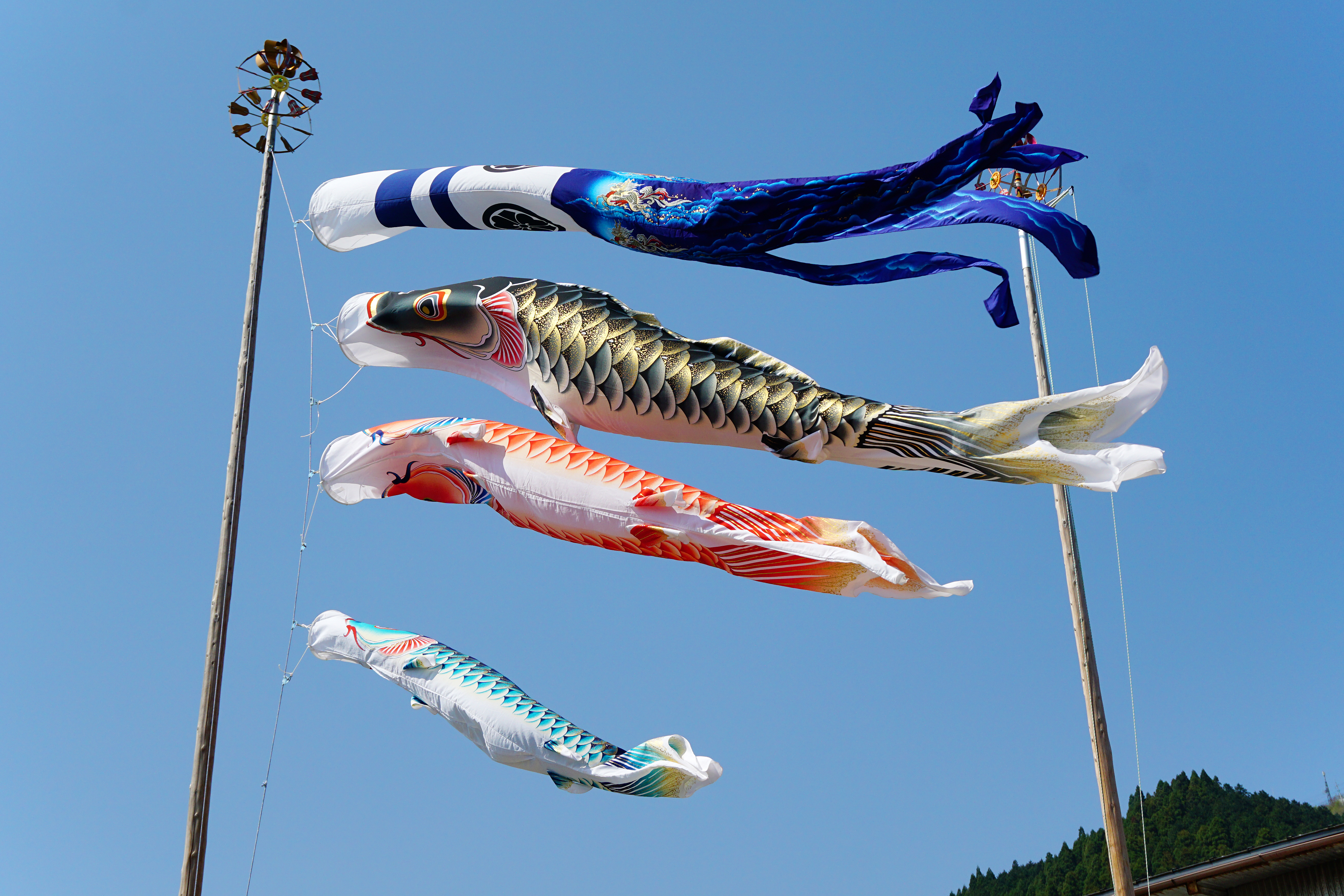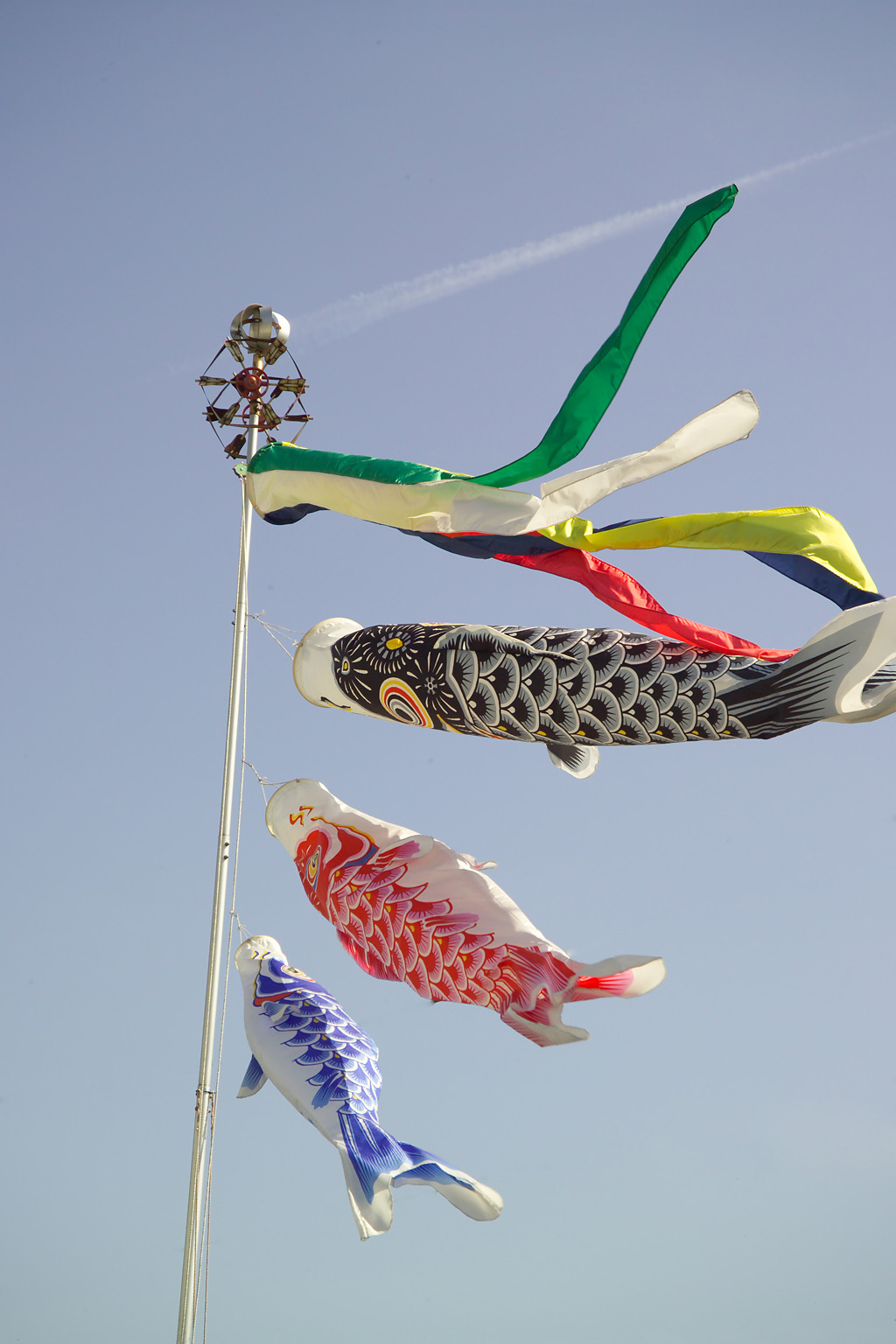Koinobori on:
[Wikipedia]
[Google]
[Amazon]


 , meaning "carp streamer" in Japanese, are
, meaning "carp streamer" in Japanese, are


 , meaning "carp streamer" in Japanese, are
, meaning "carp streamer" in Japanese, are carp
Carp are various species of oily freshwater fish from the family Cyprinidae, a very large group of fish native to Europe and Asia. While carp is consumed in many parts of the world, they are generally considered an invasive species in parts of ...
-shaped windsock
A windsock (also called a wind cone) is a conical textile tube that resembles a giant sock. It can be used as a basic indicator of wind speed and direction, or as decoration. They are typically used at airports to show the direction and strength ...
s traditionally flown in Japan to celebrate , a traditional calendrical event which is now designated as , a national holiday in Japan. are made by drawing carp patterns on paper, cloth or other nonwoven fabric. They are then allowed to flutter in the wind. They are also known as .
Children's Day takes place on May 5, the last day of Golden Week, the largest break for workers and also a week in which many businesses, state schools, and some private schools close for up to 9–10 days for the designated national holidays. Landscapes across Japan are decorated with from April to early May, in honor of children for a good future and in the hope that they will grow up healthy and strong.
The is included in Unicode
Unicode, formally The Unicode Standard,The formal version reference is is an information technology Technical standard, standard for the consistent character encoding, encoding, representation, and handling of Character (computing), text expre ...
as .
Description
A typical set consists of, from the top of the pole down, a pair of with a ball-shaped spinningvane
Vane may refer to:
People
* Vane (surname)
* Vane Featherston (1864–1948), English stage actress
* Ivan Vane Ivanović (1913–1999), Yugoslav-British athlete, shipowner, political activist, and philanthropist
* Vane Pennell (1876–1938), ...
, a mounting , and finally the . For the windsock above the , two main kinds are used: the , based on the five elements of Chinese philosophy, and , often featuring a family crest. The number and meaning of the carp streamers or that fly beneath the windsock has changed over time. Traditionally, the set would contain a black representing the father, followed by a smaller, red representing his eldest son. This is why, according to the Japanese American National Museum, in the traditional "children's song," the red one () represents the eldest son. If more boys were in the household, an additional blue, green and then, depending on the region, either purple or orange were added. After the government's decree that converted into the present , the holiday came to celebrate the happiness of both boys and girls. As a result, the red came to represent the mother of the family and it is not uncommon for the color to be varied as pink. Similarly, the other colors and sizes of carp came to represent all the family's children, both sons and daughters.
At present, the are commonly flown above the roofs of houses with children, with the biggest (black) for the father, next biggest (red or pink) for the mother, and an additional, smaller carp of a different color for each child in decreasing order by age.
range from a few centimetres to a few metres long. In 1988, a long weighing was made in Kazo, Saitama
is a city located in Saitama Prefecture, Japan. , the city had an estimated population of 112,792 in 48,213 households and a population density of 850 persons per km². The total area of the city is . The city is noted for is known throughout Ja ...
.
History
have been in use since the 18th century. Originally exclusive to warrior households, they eventually reached the rest of the population. They were traditionally flown as part of the Japanese Boys' Day, with one carp for each son, while girls found a counterpart to this custom in 'Doll's Day'. However, after the redesignation of May 5th as Children's Day in 1948, some families began flying koi for every child, regardless of gender. Despite this, the connection between the and male children remains, and many families still do not fly them for their daughters. Thekoi
or more specifically , are colored varieties of the Amur carp ('' Cyprinus rubrofuscus'') that are kept for decorative purposes in outdoor koi ponds or water gardens.
Koi is an informal name for the colored variants of ''C. rubrofuscus'' ke ...
, known for its ability to swim upstream, represents courage, determination, and the hope that children will grow up healthily. This symbolism pays homage to the myth of longmen Longmen () may refer to:
*Longmen (mythology), The Dragon Gate in Chinese mythology, located at the top of a waterfall cascading from a legendary mountain
*Longmen Grottoes, collection of Buddhist cave art in Luoyang
*Longmen Mountains, mountain ra ...
from the late Han dynasty
The Han dynasty (, ; ) was an imperial dynasty of China (202 BC – 9 AD, 25–220 AD), established by Liu Bang (Emperor Gao) and ruled by the House of Liu. The dynasty was preceded by the short-lived Qin dynasty (221–207 BC) and a warr ...
, that a golden koi fish swam up a waterfall at the end of the Yellow River
The Yellow River or Huang He (Chinese: , Standard Beijing Mandarin, Mandarin: ''Huáng hé'' ) is the second-longest river in China, after the Yangtze River, and the List of rivers by length, sixth-longest river system in the world at th ...
and became a dragon
A dragon is a reptilian legendary creature that appears in the folklore of many cultures worldwide. Beliefs about dragons vary considerably through regions, but dragons in western cultures since the High Middle Ages have often been depicted as ...
.
The number of included on a pole and the variety of their colors have increased over time to accommodate more family members. The nobori
is a Japanese banner. They are long, narrow flags, attached to a pole with a cross-rod to hold the fabric straight out and prevent it from furling around the rod; this way, the field is always visible and identifiable.
History of use
The ''nob ...
where originally made by hand-painting materials such as paper or cloth, but these have almost entirely fallen out of use in favour of synthetics, outside of some rural areas. Silk and paper models are still sold, but at a higher price than the synthetics. Related traditions include kite-flying, kite-fighting, the consumption of Kashiwa mochi
Kashiwa mochi (Japanese: かしわ餅, 柏餅) is a wagashi (Japanese confection) of white mochi surrounding a sweet ''anko'' (red bean paste) filling with a Kashiwa leaf wrapped around it. Unlike the cherry blossom leaf used in sakura mochi, the ...
(sticky rice cakes wrapped in oak leaves), and, in some areas, the tradition of making young boys crawl through the for good fortune. As a tradition, throughout Children's Day, children also thank and show respect for relatives, parents, and teachers for support throughout their life.Asia Kids Society. (2009). Children's Day in Japan: Kodomo no Hi. Retrieved from http://kids.asiasociety.org/explore/childrens-day-japan-kodomo-no-hi
song
A famous song often sung by children and their families. It was published in in 1932. The lyrics are by Miyako Kondō (). The composer is unknown.See also
*Dragon Boat Festival
The Dragon Boat Festival ( zh, s=端午节, t=端午節) is a traditional Chinese holiday which occurs on the fifth day of the fifth month of the Chinese calendar, which corresponds to late May or June in the Gregorian calendar.
Names
The Engl ...
References
External links
*{{Commons category-inline Festivals in Japan Japanese-language songs Japanese words and phrases Japanese folk art Articles containing video clips